How to Know If a Four-Day Workweek Is Right for Your Business
The four-day workweek has become one of the most talked-about workplace shifts of the last decade. Large corporations are experimenting with it....

In the fast-paced world of business, growth isn’t just a buzzword—it’s a necessity. For small business owners and entrepreneurs, understanding and accurately measuring growth can be the difference between success and stagnation. Whether you’re just starting out or looking to scale your operations, knowing how to track and interpret growth metrics is crucial.
When we talk about growth in a business context, we often think about revenue. However, growth encompasses much more than just financial gains. It includes the expansion of skill sets, adoption of new technologies, and improvements in efficiency. While some of these aspects are harder to measure, focusing on revenue growth can provide a clear and straightforward benchmark.
Now, let's explore the steps you can take to measure your company’s growth effectively.
The simplest way to measure growth is by looking at your profit and loss (P&L) statement. Compare your income over different periods, such as month-to-month or year-over-year.
Example:
💡When you regularly compare these figures, you can identify whether your business is growing, stagnating, or declining.
Leading indicators predict future growth. They might include:
Lagging indicators confirm past growth. They include:
💡Monitor these indicators to get a comprehensive view of your growth trajectory.
Customer Acquisition Cost (CAC) is the total cost of acquiring a new customer. This includes marketing, sales, and any other expenses associated with gaining new business.
Formula:
CAC = Total Marketing & Sales Expenses / Number of New Customers Acquired
Customer Retention Rate measures how well you keep your customers over time.
Formula:
Retention Rate = ((Number of Customers at End of Period - New Customers Acquired During Period) / Number of Customers at Start of Period) * 100
💡Track these metrics to understand the effectiveness of your customer acquisition strategies and the loyalty of your existing customers.
Average Transaction Value (ATV) reveals the average amount each customer spends per transaction, providing a clear indication of customer spending habits. By focusing on increasing this metric, you can drive up your revenue per customer and ultimately boost your overall financial performance.
Formula:
ATV = Total Revenue / Number of Transactions
Similarly, Purchase Frequency measures how often the same customers make purchases within a given period. By encouraging repeat purchases and fostering customer loyalty, you can increase the frequency of transactions, leading to a steady stream of revenue.
Formula:
Purchase Frequency = Total Number of Purchases / Total Number of Customers
💡Increasing either of these metrics will directly impact your overall revenue growth.
Attrition or churn rates refer to the percentage of customers who stop buying from you over time. High attrition rates can significantly impact growth.
Formula:
Churn Rate = (Number of Customers Lost During Period / Number of Customers at Start of Period) * 100
💡Understanding why customers leave can help you implement strategies to reduce churn, such as improving customer service or offering loyalty programs.
Growth often comes at a cost. Whether it’s marketing expenses, hiring new staff, or investing in new technology, ensure you account for these costs in your growth plan.
Cost of Acquisition Rate (CAR) measures how much you spend to bring in new revenue.
Formula:
CAR = Total Acquisition Costs / New Revenue Generated
💡Comparing your CAR with the revenue generated helps you determine whether your growth strategies are cost-effective.
Measuring a company’s growth isn’t just about tracking revenue—it’s about understanding the multifaceted aspects that contribute to your business’s success. From examining profit and loss statements to evaluating customer retention and acquisition costs, a comprehensive approach will give you a clearer picture of your growth trajectory.
Remember, growth should be sustainable and aligned with your long-term business goals. When you take these steps, you can effectively measure and understand your company's growth, setting the stage for continued success and expansion.
Ready to take your growth to the next level? Get in touch with our experts for personalized growth strategies tailored to your business needs.

The four-day workweek has become one of the most talked-about workplace shifts of the last decade. Large corporations are experimenting with it....

We've all seen the headlines. Another major company announces that everyone needs to be back at their desk. No exceptions. And if you're running a...

If you work with a payroll provider for your small business, payroll typically runs on a set schedule with very little day-to-day involvement from...